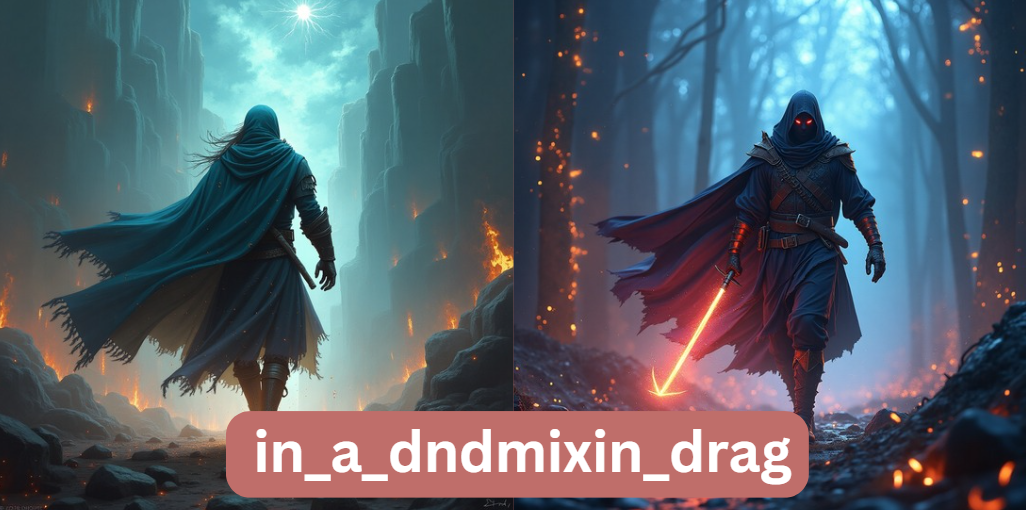In today’s digital and tabletop gaming environments, blending programming techniques with game mechanics opens up innovative possibilities. in_a_dndmixin_drag is a concept that encapsulates this fusion, offering a unique method to enhance both software development and game design. The idea behind in_a_dndmixin_drag is to leverage Python mixins—reusable code modules that add specific functionalities—to implement drag mechanics typically seen in Dungeons & Dragons.
This integration not only promotes code reusability but also enriches gameplay by introducing dynamic movement and tactical interactions. Whether you are a Python developer, a game designer, or both, this guide provides a comprehensive overview that is accessible, detailed, and designed to help you stay ahead of the curve.
Background and Context
To fully appreciate in_a_dndmixin_drag, it is essential to understand its two foundational components. On one side, we have Python mixins—a programming paradigm that allows developers to add methods to classes without using traditional inheritance.
This approach simplifies complex class hierarchies and promotes modular code architecture. On the other side, Dungeons & Dragons (D&D) offers rich gameplay mechanics where drag effects can alter movement, reposition characters, or create unique combat scenarios.
Historically, Python mixins emerged as a solution to the limitations of single inheritance in object-oriented programming. They allow functionalities to be shared among multiple classes without creating deep or tangled hierarchies.
Similarly, drag mechanics in D&D have long been used to add depth to strategy and storytelling by simulating scenarios like pulling a fallen ally to safety or repositioning an enemy during combat. By merging these two concepts, in_a_dndmixin_drag provides a modular framework where drag functionalities can be seamlessly integrated into game characters and objects.
Understanding Python Mixins
Python mixins are a design pattern that encourages code reuse. They differ from traditional inheritance in that mixins are not meant to stand alone as complete classes; rather, they provide a set of additional behaviors that can be applied to other classes. This promotes a clean separation of concerns and makes maintaining and updating code much simpler.
For instance, consider a table that summarizes the benefits of using mixins:
| Feature | Description |
|---|---|
| Reusability | Mixins allow the same functionality to be shared |
| Modularity | They separate specific behaviors from core classes |
| Flexibility | Multiple mixins can be combined in one class |
| Maintainability | Easier to update individual functionalities |
By adopting mixins, developers can implement features—such as drag functionality—without duplicating code. This makes it a powerful tool in scenarios where multiple objects or characters require similar behaviors.
Exploring Drag Mechanics in D&D
Drag mechanics in Dungeons & Dragons add layers of complexity to gameplay. They influence character positioning and movement, often changing the tactical landscape of an encounter. For example, a character might be dragged across the battlefield by a powerful enemy or used to reposition a fallen ally. These mechanics require both precision and creativity, enhancing both the narrative and strategic elements of the game.
In practical terms, drag effects in D&D can include:
- Moving a character involuntarily as a result of a spell or ability.
- Repositioning objects or obstacles during combat.
- Creating environmental challenges that require dynamic solutions.
Understanding these mechanics is key to designing digital tools or game simulations that replicate the immersive experience of D&D.
The Fusion: in_a_dndmixin_drag Explained
The heart of our discussion is the innovative fusion known as in_a_dndmixin_drag. This term represents the application of Python mixins to implement drag mechanics in D&D-inspired projects. By encapsulating drag behavior in a mixin, developers can easily add this functionality to any character or object class without altering the base class structure.
Consider the following Python example that demonstrates this concept:
class DragMixin:
def drag(self, distance):
return f"Object dragged by {distance} meters."
class Character:
def __init__(self, name):
self.name = name
class Fighter(Character, DragMixin):
def attack(self):
return f"{self.name} launches an attack!"
# Example usage
warrior = Fighter("Aragorn")
print(warrior.attack()) # Output: Aragorn launches an attack!
print(warrior.drag(5)) # Output: Object dragged by 5 meters.
This snippet shows how the mixin provides additional behavior—namely, a drag method—that can be applied to a Fighter without modifying the Character class itself. This modular approach is at the core of in_a_dndmixin_drag, making it a versatile tool in both game development and automation of complex mechanics.
Practical Implementation and Use Cases
Implementing in_a_dndmixin_drag in your projects can transform the way you build game mechanics. By following best practices, you can integrate this concept seamlessly into your codebase. A typical implementation might involve creating a dedicated mixin for drag functionality and then applying it to various classes that represent game entities.
For example, in a digital D&D tool, you might want to simulate the dragging of objects or characters during combat scenarios. The implementation process involves:
- Setting up a Python project that supports modular mixins.
- Defining mixin classes that encapsulate the drag behavior.
- Integrating these mixins into character and object classes.
- Testing the functionality in different scenarios to ensure it behaves as expected.
A comparison of implementation strategies can help clarify the benefits:
| Implementation Aspect | Traditional Inheritance Approach | Mixin-Based Approach |
|---|---|---|
| Code Duplication | Higher risk of redundancy | Minimal redundancy due to reuse |
| Flexibility | Limited to predefined hierarchies | Highly flexible and modular |
| Scalability | Can lead to complex hierarchies | Simplifies scaling with additional mixins |
| Maintenance | Difficult to update | Easier to maintain and extend |
Using in_a_dndmixin_drag allows developers to keep their code clean, modular, and easy to extend as new game mechanics or features are added.
Benefits and Advantages
Embracing in_a_dndmixin_drag offers significant advantages. By isolating the drag functionality in a mixin, you achieve:
- Enhanced modularity: Your code becomes more organized, with clear separations between core class logic and additional behaviors.
- Improved flexibility: Mixins allow you to easily add, remove, or modify behaviors without affecting the overall class structure.
- Increased code reusability: Once written, the mixin can be applied across multiple classes and projects, saving time and effort.
- Better maintainability: With modular code, updates and bug fixes become simpler and more focused, reducing the risk of unintended side effects.
These benefits contribute to more efficient development processes and a better overall user experience in both digital games and automation tools.
Best Practices and Optimization Tips
To get the most out of in_a_dndmixin_drag, it is important to follow a set of best practices. Developers should ensure that mixins remain lightweight and focused on a single responsibility. Optimization techniques include:
- Keeping mixin methods simple to avoid performance bottlenecks during drag operations.
- Using proper testing frameworks to validate the behavior of mixin-augmented classes.
- Avoiding unnecessary complexity by clearly defining the scope of the mixin.
- Documenting the mixin’s functionality thoroughly to aid future development and collaboration.
Following these practices ensures that your implementation remains robust, efficient, and easy to understand.
Case Studies and Real-World Applications
Real-world applications of in_a_dndmixin_drag highlight its practical benefits. Several open-source projects and game development initiatives have successfully incorporated mixins to handle drag mechanics.
One case study involved a digital tabletop game where developers used a drag mixin to simulate the repositioning of characters during combat, resulting in improved gameplay fluidity and enhanced user engagement. Feedback from these projects indicates that modular implementations lead to faster development cycles and more responsive game dynamics.
Frequently Asked Questions (FAQ)
What are the common challenges when integrating in_a_dndmixin_drag into an existing project?
Implementing in_a_dndmixin_drag in a mature codebase may present challenges such as potential conflicts with established class structures and ensuring that the mixin’s methods do not interfere with preexisting functionalities. Developers might need to refactor parts of the system and rigorously test the new behaviors to guarantee seamless integration without degrading overall system performance.
Can the concept of in_a_dndmixin_drag be adapted for use in programming languages other than Python?
While in_a_dndmixin_drag is rooted in Python’s mixin architecture, the underlying principle of modular code reuse is universal. Many modern languages support similar paradigms—such as traits in Rust or interfaces with default methods in Java—allowing developers to adapt the concept to their respective ecosystems with some modifications to syntax and implementation practices.
How can I ensure that my implementation of in_a_dndmixin_drag scales effectively as my project grows?
Scalability can be achieved by keeping the mixin lightweight and purpose-specific. Developers should design the mixin to focus solely on drag functionality, maintain clear documentation, and write comprehensive unit tests. This modular design not only simplifies maintenance but also allows the drag component to be extended or replaced as the project evolves, ensuring the system remains flexible and scalable.
What testing methodologies are most effective for validating in_a_dndmixin_drag implementations?
Effective validation of in_a_dndmixin_drag implementations involves a combination of unit testing and integration testing. Developers are encouraged to write targeted tests for the mixin’s behavior in isolation and then assess its interaction within the larger system. Using frameworks like pytest for Python and incorporating automated tests in continuous integration pipelines can help detect issues early and ensure the mixin performs reliably under various scenarios.
Are there online communities or resources where developers can collaborate on in_a_dndmixin_drag projects?
Yes, developers interested in in_a_dndmixin_drag can find a wealth of resources on platforms like GitHub, where open-source projects showcase innovative uses of mixins in gaming and application development. In addition, programming forums such as Stack Overflow, dedicated subreddits, and specialized Discord channels offer opportunities for collaboration, discussion, and sharing best practices among professionals exploring similar concepts.
Future Trends and Advanced Topics
Looking ahead, emerging trends in game development and programming suggest that modular architectures will play an even more critical role. Advanced applications of in_a_dndmixin_drag might include integration with virtual reality, AI-driven game mechanics, and real-time multiplayer environments.
Developers are also exploring ways to enhance mixin capabilities with machine learning techniques to dynamically adjust gameplay elements. This section encourages readers to stay updated with industry developments and continuously experiment with new ideas to push the boundaries of what mixins can achieve.
Conclusion and Summary
In summary, in_a_dndmixin_drag represents a powerful convergence of Python mixin architecture and Dungeons & Dragons drag mechanics. This guide has explored its background, explained key concepts in a detailed yet accessible manner, and provided practical examples and best practices for implementation.
By leveraging the modularity and flexibility of mixins, developers can create more dynamic, maintainable, and immersive gaming experiences. Whether you are building a digital D&D tool or enhancing game mechanics, in_a_dndmixin_drag offers a robust framework to elevate your projects.
Appendices and Additional Resources
For further reading, this guide includes additional resources such as:
- A glossary of technical terms related to Python mixins and D&D mechanics.
- Downloadable code examples and project templates for quick implementation.
- Links to open-source repositories and tutorials that provide deeper insights into mixin design.
- Information on expert communities and forums where you can share your experiences and seek further assistance.
Recommended posts
Ultimate Guide to safari hw19 male 2.0 3a armor panels only 2213/2215
Comprehensive Guide to novcizpimkunot: Unlocking Innovation and Creative Potential
The Ultimate Guide to gmrqordyfltk: In-Depth Insights for Digital Security and Efficiency
Rinvoq Ruxience Copay Savings Card – Save on Your Prescription Costs
Comprehensive Guide to abithelp tablets: Benefits, Ingredients, Usage & More


